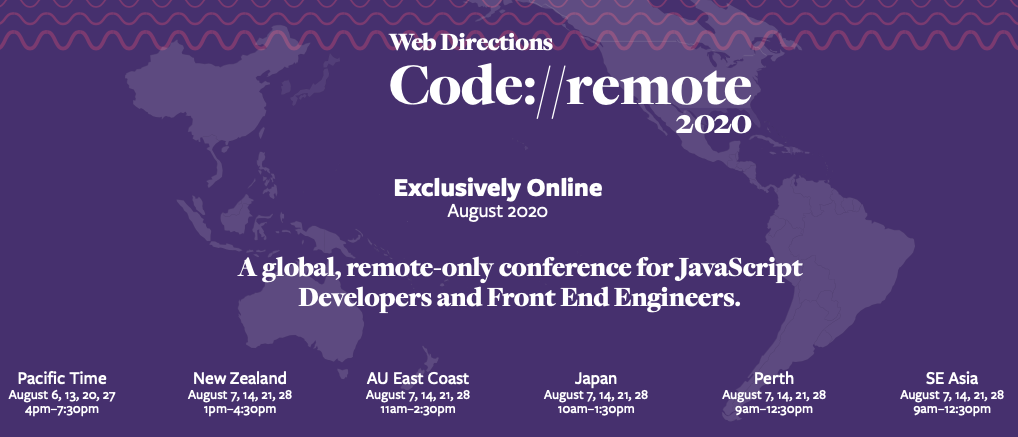The future of Web Directions, part I. The Shape of online conferences
In early March, shortly after it became apparent that face-to-face events weren’t going to be feasible for some time we quickly announced that our Code conference would be going online. Although a little later than we had planned it, and online rather than in-person it was largely unchanged otherwise.
We saw, and are continuing to see a lot of events attempting to do this–bring the in-person experience online, with as little changed as possible, very frequently following the same playbook.
- Content live streamed (sometimes two or even three times in a 24 hour period to reach wider audiences) from wherever the speaker is located
- Audiences expected to set aside multiple straight days, and then sit through hour after hour of screen based presentations.
As was our initial impulse too, this approach of adhering as closely as possible to the existing ways of doing things is understandable. But is it the right approach? In the immediate wake of the move here in Australia and in many parts of the world to lockdown, we, like so many people understandably sought comfort in the idea that things might not really change too much. That this would all blow over soon and we’d all go “back to normal”. But it’s clear even as some aspects of the impact of COVID19 begin to ease, at least for some people, in some places, that the future, in large ways and small will be significantly different from what it looked like before.
We are increasingly of the mind that just as workshops and tutorials, which we used to host and run, have moved increasingly online over the last decade or so, the shift of conferences online is a structural one. And while there will be face to face events again, and we hope to host those again too, many conferences will remain online only.
In the light of this, we’ve taken the time to step back, to think deeply about what an online-only conference can look like when re-imagined. And it definitely looks a little different. Maybe a lot different. But we believe strongly for the better.
What “Job” does a conference do?
While it has its fair share of critics as well as adherents, we’ve long found Clayton Christensen’s “Jobs to be done” theory a valuable way of thinking about the value we deliver to our audience.
Jobs Theory goes beyond superficial categories to expose the functional, social, and emotional dimensions that explain why customers make the choices they do. People don’t simply buy products or services; they pull them into their lives to make progress. We call this progress the “job” they are trying to get done, and understanding this opens a world of innovation possibilities
Jobs to Be Done, Christiensen Institute
So why do people choose to attend a conference (or to send the people in their team). What progress are people looking for? What job done?
At a high level, concepts like “education”, or “professional development” come to mind. But on closer inspection we feel there are two key things we deliver for our audiences. There’s an educational component, but importantly too there’s developing a sense of connection.
Known Knowns, and Unknown Unknowns
Given 75% or more of the time a person spends at a conference is most likely listening to presentations, the educational component is critical. But, not all education is the same. This is at the heart of the difference between a workshop and a conference. People take a workshop based on a need to make a well defined transition–from one level of capability in a technology (say React, or CSS), or set of practices (for example conducting research interviews), to a more advanced level. It’s a journey from one “known known” to another “known known” (or perhaps from “known unknown” to “known known”) in Donald Rumsfield’s widely derided but actually rather useful formulation.
Conferences, we feel, really do something different (and this is at the essence of how we program our conferences and our overall editorial approach). Having run dozens of conferences and watched hundreds if not thousands of presentations, we’ve found really great conference presentations are of course engaging, entertaining, clear and concise. But they also address unknown unknowns–they help an audience chart out their knowledge, and the gaps in their knowledge. They can provide a sense check that you are on the right track when it comes to a particular technology or approach, or open up new areas to explore and focus on.
So, while you won’t be fully able to implement origin trials after watching a great presentation, you’ll know why they exist, why they are important and have a sense of whether they are something that meets a need you already have, or could solve a problem for you. Workshops, tutorials and the like can then help you complete that knowledge.
But there’s also a second “Job” we uncovered–helping develop people’s sense of connection and belonging to a professional community. Conferences help do this by providing breaks and social events, as well as a shared experience to discuss (that’s another important role presentations play). Spaces in which people can seek out old colleagues, or acquaintances, or strike up new conversations.
When rethinking what a conference is when it’s not in-person, but rather online, we started not by asking, how do we bring the in-person experience online. Instead we asked, how can we do these jobs for our audience, now we’re online and no longer in-person
The shape of our online conferences
We’ve just announced our first two fully remote conferences, Code://Remote, and Product://Remote. Taking place in August and October this year respectively, and building on our thinking outlined avoid, they will be quite different from in-person events, and most (if not all) the online conferences we’re seeing. Here are some of the key ways they’ll differ, and the motivation for and thinking behind these choices.
Pre-recorded presentations
Presentations will be pre-recorded, with a strong focus on production values (lighting, sound quality, legibility of code examples, and so on), editing and post-production. These will be screen-first presentations.
This first, and we think perhaps most critical decision was one that in many ways I had the most concern about, not because on reflection it didn’t seem an increasingly good idea, for reasons we’ll discuss shortly, but because I felt our potential audience might respond instinctively that it was simply too different from what you’d expect from a ‘conference.’
Our instinct is increasingly people’s expectations of screen based content will be closer to what we expect from streaming services like Netflix, than the zoom meetings so many of us are participating in every day. We’re fortunate to have been working with film-maker Matheus Siquiera for some years on our conference videos, and he’ll help us ensure amazing production.
Pre-recording also allows us to transcribe and caption, create audio descriptions, make slides more accessible, even translate into other languages, making for more inclusive, accessible and engaging content.
Meanwhile speakers can even interact with the audience, or add more value to their presentation, while it is actually taking place–perhaps clarifying a point in response to a (text based) question, providing links for further reading, and so on.
Speakers, and long time attendees have both responded enthusiastically to the idea–one speaker said they find the most challenging type of presentation live streaming, and they are incredibly self conscious while doing so, more so than when on stage, but the idea of pre-recording made them feel much more comfortable.
It turns out once you rethink a key constraint, like the need for real-time presentations, a whole range of opportunities and benefits emerge to create something different, but in many ways better.
Not two straight day, a month of shorter blocks of presentations
Instead of expecting people to take two whole days out of their most likely much more unsettled than normal schedule and spend yet another 12 hours staring at the screen over consecutive days, our online conference program will take place weekly, across a whole month, with sessions approximately 3 and a half hours each week on a Friday. Making them something to look forward to toward the end of each week, and with more opportunity to digest than is available in a single sitting.
It’s the same amount of content, just not crammed into a short period of time. Which provides more time for reflection, time to ponder and absorb, rather than always racing onto the next thing.
And because the length of each session is much shorter than a full day, it turns out you can reach a far wider audience at a more reasonable time (office hours or shortly after). So, from New Zealand, right across Australia, up into Singapore, Malaysia, Indonesia, The Philippines, Hong Kong, Japan, Korea, a huge swathe of the world, we’ll be taking place during office hours. And for those on the Pacific Coast of Canada and the US, we’ll take place from afternoon to early evening–not quite office hours, but still very convenient for many.
It’s not only about convenience–many communities of practice that align with our conferences are global, with folks regardless of where they live connecting via Twitter, Slack, Discord and other tools. But rarely if ever do these folks have the opportunity to attend a conference together. Now they can!
Once again, by rethinking conventions and constraints, something different but in many ways potentially better, can emerge.
Enabling connecting and connections
Given the importance of connection and community we’ve seen was a job conferences do for their audience, we’re thinking hard about how to support networking and connections between attendees, in ways that are inclusive, safe and respectful. We want to help attendees connect with people they’ve met before (as is often the case at our in-person events) as well as meet new people in our industry, one of the reasons many attend our events.
While it may seem connecting online is a poor substitute for the opportunity to connect with people face-to-face, particularly for a new connection, maybe people actually find it more comfortable to connect initially online. Again, different, but in many ways better.
Different, but in many ways better
Yes, our online conferences will be in many ways different from the in-person events you may have attended, and they will be different from every online conference we’ve seen announced or held so far. But we also feel they will be in many ways better, by going back to first principles, asking what jobs we do for our attendees, then looking to do those jobs, in ways that may well be a little (or a lot) different than we’ve done that before.
We are genuinely excited to be exploring these opportunities, as challenging as these times are. We hope you share our enthusiasm, and maybe even join us!
Attend Code://Remote, in August
Pricing will be a little different too, with each of our first two announced conferences, Code://Remote and Product://Remote priced at $195 early bird and $295 full price (after June 30).
But both are also included in our Conffab Premium membership which costs $395 a year or just $39.95 a month (check out the link if you want to know more about this there new initiative our ours we’ll be talking more about soon).
Employment impacted? Pay what you can
If your employment has been affected by COVID19, we feel it is important for people to be able to continue their professional development, and connections with the industry, so we’ve got pay what you can pricing–choose the price you can afford, and get full access to the conference

Great reading, every weekend.
We round up the best writing about the web and send it your way each Friday.
